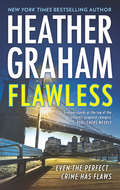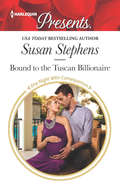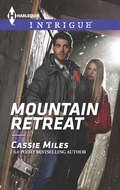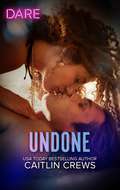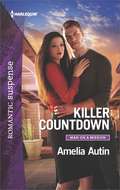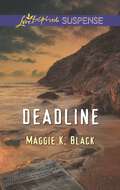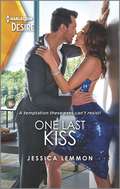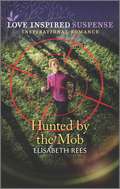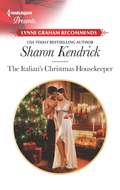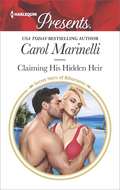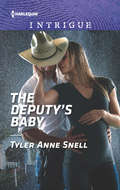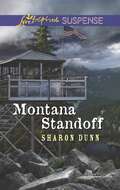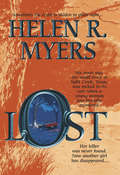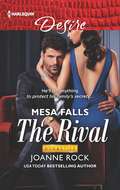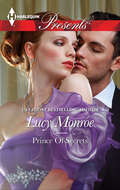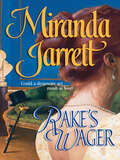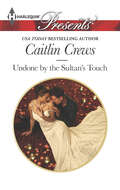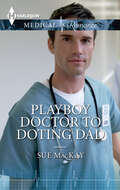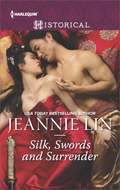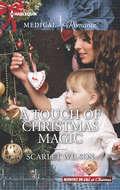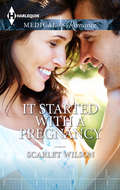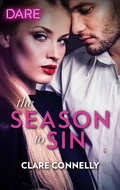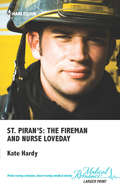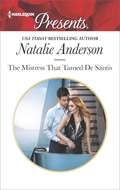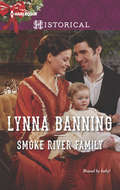- Table View
- List View
Flawless: Flawless All The Pretty Girls Saint's Gate The Secret Sister (New York Confidential #1)
by Heather Graham“Intricate, fast-paced, and intense, this riveting thriller blends romance and suspense in perfect combination and keeps readers guessing and the tension taut until the very end.” —Library JournalNew York’s Diamond District has been hit by a rash of robberies, and then Kieran Finnegan is stuck in the middle of one! The criminal psychologist is trying to “unsteal” a stone taken by her light-fingered youngest brother. But try telling that to the hardnosed FBI agent, Craig Frasier, who saves her from the thieves.When the robberies turn violent, the police and FBI wonder if there may be two gangs: the original and a copycat group using the crime to cover a murder. The killers seem to think their scheme is as flawless as the stones they steal. Thrown together by circumstance, Kieran and Craig are both assigned to the case. But to Kieran’s horror, there’s more and more evidence that somehow her family’s pub, Finnegan’s on Broadway, is involved. Because everyone goes to Finnegan’s…and someone doesn’t want the cracks in their plans revealed…FBI Agent Craig Frasier and criminal psychologist Kieran Finnegan meet for the first time in the page-turning beginning to the New York Confidential series, only from New York Times bestselling author Heather Graham.Don’t miss the other incredible stories in this series!FlawlessA Perfect ObsessionA Dangerous GameA Lethal LegacyThe Final Deception
Bound to the Tuscan Billionaire: A Billionaire Romance (One Night With Consequences)
by Susan StephensNine months to claim what's his! For gardener Cassandra Rich, working in the foothills of Tuscany is the perfect way to escape her past. Until the man of the manor graces the villa with his presence and Cassandra with his attention. Marco di Fivizzano can't take his eyes off the delectable Cass. So when he requires a plus one for a gala, Marco will uncover who this fiery blonde is-over dinner, or in his bed! In Marco's arms, Cass blossoms, finding the freedom she's always craved...until she discovers she's pregnant and bound to the billionaire forever!
Mountain Retreat: Mountain Retreat Gut Instinct Infiltration
by Cassie MilesHer fiancé, a marine held captive for months in a war-torn country, is back on American soil...with secrets. For six agonizing months, Sidney Parker had no idea if her beloved fiancé, a US Marines captain, was alive or dead. Held captive in a South American dictatorship, Nick Corelli is suddenly back home in Texas. But instead of the romantic reunion Sidney expects, Nick is working with the CIA-and another mysterious agency-on a covert mission. One that places Sidney's life in jeopardy. When the safe house meant to protect them is compromised, Nick rushes Sidney to a mountain retreat...and now she wants answers. Yet their greatest enemy is lying in wait for the ultimate showdown.
Undone: A Holiday Fling Romance (Hotel Temptation #2)
by Caitlin CrewsUSA TODAY bestselling author Caitlin Crews delivers with the second smoking-hot installment in her Hotel Temptation series! Maya Martin’s been a very good girl… Now she’s learning to be bad!Ditched at the altar by a fiancé who accuses her of being boring in bed, prim lawyer Maya Martin goes on a solo Amalfi Coast honeymoon with one goal in mind: proving her ex wrong! And when she meets tattooed, hard-bodied Charlie Teller, he seems just the man for the job.He’s so hot it’s criminal! From his muscled chest to his powerful thighs, from his low-slung jeans to his scuffed boots, Charlie is no uptight suit. And he isn’t afraid to get his hands dirty—whether it’s repairing fences or making Maya moan against the stone walls of an ancient Italian villa. But is Charlie really who he appears to be? He’s a man of few words, though they’re all the right ones!Making love under the Italian sun, exploring each other, satisfying their every desire…Charlie’s helping Maya unleash her wild side…over and over again! What happens when she finds out who he is and where he comes from? Will her feelings change? Can lust turn into love, even if he’s been hiding the truth?Sexy. Passionate. Bold. Discover Harlequin Dare, a new line of fun, edgy and sexually explicit romances for the fearless female.
Killer Countdown: The Pregnant Colton Bride Beauty And The Bodyguard Killer Countdown Covert Alliance (Man on a Mission #8)
by Amelia AutinA reporter helps a sexy senator evade a deadly assassin in this thrilling Man on a Mission taleTV reporter Carly Edwards has the scoop of a century! She's discovered that Senator Shane Jones was diagnosed with a life-altering illness, but she can't help but be drawn to his courage. So when Shane saves Carly's life from a killer, she resolves to keep her story—and the irresistible politician—alive…A politician and a media personality are a recipe for romantic disaster. The last thing Shane wants is to endanger Carly. But how can he prevent her from getting close when the very air between them sizzles? As their lives are threatened, Shane realizes Carly's the one woman he wants forever—if he can keep them both safe!
Deadline
by Maggie K. BlackTHE PERFECT CRIME No one but reporter Jack Brooks believes three seemingly unrelated deaths are the work of a clever serial killer. Not even the woman he's convinced is the next victim-beautiful wedding planner Meg Duff. Even when he tracks her to her remote Canadian island home in time to save her life, Meg can't-and won't-help the maverick reporter. But time is running out, and as a record storm threatens the island, a killer grows desperate. Only Jack can stop him from getting away with murder. And he must, because now not only is Meg's life at stake, but so is his heart....
One Last Kiss: A workplace reunion romance (Kiss and Tell #3)
by Jessica LemmonThese exes really shouldn&’t be sharing a kiss…should they? Find out in the finale of Jessica Lemmon&’s sizzling Kiss and Tell series. She was poised to say &“we shouldn&’t.&” He kissed her before she could speak. Gia Knox-Cooper and Jayson Cooper have the &“perfect&” divorce—they still work together and Jayson remains close with her family. But there&’s something about the spark between them that just can&’t be extinguished. And therein lies the problem: they keep coming back for one more kiss…even though their marriage was a trainwreck they just can&’t repeat. Now, they&’re attending the wedding of Gia&’s brother, but &“I do&” has barely been said before they&’re ditching their dates for each other. Now it&’s déjà vu all over again as they vow this will only be for the wedding weekend. But as they return to the office, the passion is still going strong…and so is everything that once pushed them to the brink… From Harlequin Desire: A luxurious world of bold encounters and sizzling chemistry.Love triumphs in the Seattle tech world in the Kiss and Tell series.Book 1: His Forbidden KissBook 2: One Wild KissBook 3: One Last Kiss
Hunted by the Mob
by Elisabeth ReesAn FBI agent in the crosshairs…with a bounty on her head.An assignment turns deadly when FBI agent Goldie Simmons is forced to kill to protect her witness…and has a hit placed on her in retaliation. Now instead of working the case, she’s under the protection of fellow agent Zeke Miller, her long-lost childhood sweetheart. And learning to trust him again is her only hope of staying alive.
The Italian's Christmas Housekeeper: A Classic Christmas Romance (Mills And Boon Modern Ser.)
by Sharon KendrickFrom making the billionaire’s bed…To Christmas between his sheets!Shy housekeeper Molly Millar always tries her best. She’s anxious to impress outrageously wealthy houseguest Salvio de Gennaro, but instead is unfairly criticized by her employer! When she’s found sobbing by Salvio, he comforts her…with the most amazing experience of her life. But when that incredible encounter costs Molly her job, Salvio rescues her with an irresistible proposition: become his temporary housekeeper—just in time for Christmas!“The author built up a beautiful, tempestuous love story” —Goodreads Reader on The Pregnant Kavakos Bride“Ms. Kendrick has penned a really good read in this book” —Harlequin Junkie on The Sheikh’s Bought Wife
Claiming His Hidden Heir: A Secret Baby Romance (Secret Heirs of Billionaires #13)
by Carol Marinelli“Did you forget to tell me about my baby?”He won’t be denied his heir!Buttoned-up PA Cecelia Andrews’s resignation released her secret raw desire for her demanding playboy boss, Luka Kargas. One year after his callous dismissal, Cecelia’s hiding an even greater secret—their daughter! She’ll never let coldhearted Luka make her daughter feel unwanted. But when Luka uncovers her deceit, there’s no escaping the consequences of her passionate surrender…
The Deputy's Baby: A High-Stakes Police Procedural (The Protectors of Riker County #5)
by Tyler Anne SnellDanger brought them back together.Will a secret baby tear them apart?As the newest deputy in town, Henry Ward is hoping to escape painful memories. Then a rain of bullets brings his history rising up again, throwing Cassie Gates directly into his path. He hasn’t forgotten their night together, seven months ago. And now that he’s seen her—pregnant with his child—Henry knows he’s fighting more than his past. He’s fighting for his future.The Protectors of Riker County
Montana Standoff
by Sharon Dunn"TELL US WHERE HE IS AND WE'LL LET YOU GO..." Kidnapped and dragged into the Montana wilderness, Sarah Langston has no idea where her brother is or what her captors want with him. But when help arrives and removes her blindfold, she's shocked to see the father of the baby she gave up for adoption. Former policeofficer Bryan Keyes is convinced that Sarah's kidnapping is tied to a deadly human trafficking ring. Now with Sarah's brother in the line of fire, Bryan must join forces with the only woman he's ever loved. Will they have time to rekindle a love that happened too soon?
LOST
by Helen R. MyersWhen Faith Ramey's abandoned car is discovered, the town can't help feeling an unwelcome sense of déjà vu. Police Chief Jared Morgan doesn't to believe there's a connection, but Faith's sister, Michaele, is beginning to suspect otherwise. She has sacrificed everything-including her true feelings for Jared-to ensure her younger sister's future. Now, losing Faith could do more than crush her...it might destroy the entire community.As secrets and scandals are exposed, old fears-and new-spawn doubt and suspicion. Is a sinister stranger lurking behind the murder and Faith's disappearance-or does something in Split Creek have blood on their hands? Only Michaele's fierce determination-and her trust in Jared-will help her see the truth hidden in plain sight.
The Rival (Dynasties: Mesa Falls #2)
by Joanne RockUSA TODAY Bestselling AuthorThey both have something to hide,but their chemistry can’t be contained…Media mogul Devon Salazar wants Regina Flores, but his desire is tempered by suspicion. With sibling rivalry and his father’s secrets threatening the family empire, Devon can’t afford to trust Mesa Falls Ranch’s nosy new hire. This won’t stop him from seducing her. He looks forward to seeing Miss Flores exposed… Until the tables turn and Regina reveals their surprising connection…A Dynasties NovelWhere family loyalties and passions collide…Visit Mesa Falls
Prince of Secrets: A Contemporary Royal Virgin Romance (By His Royal Decree #2)
by Lucy Monroe100% Determined 100% Devastating! Prince Demyan Zaretsky does whatever it takes to protect his country. So seducing Chanel Tanner will be easy. And marriage? An unfortunate side effect of duty. She unwittingly holds the economic stability of Volyarus in her hands...and he must secure it. With his royal identity and intent disguised, Demyan sets about a ruthless seduction designed to make Chanel lose her mind with ecstasy. But when he discovers she is a virgin, he uncovers something in himself-a conscience. Now his plan takes a shocking turn-one this dark-hearted prince had never anticipated!
Rake's Wager
by Miranda JarrettThe Rake’s ReformCassia Penny runs a fashionable gaming house in Regency London. Her inspired style has always set the fashion...which is just the sort of talent Richard Blackley needs.Blackley is a self-made millionaire, determined to establish himself as a proper London gentleman. When Cassia loses a wager, he collects by demanding her services to refurbish his decrepit estate-but finds her beauty the most gracious adornment his home could have.Now, as she transforms the old house, she transforms Richard, as well. The unlikely pair are drawn together-until an old secret from Richard’s past reappears. Will it tear them apart...or unite them forever?
Undone by the Sultan's Touch
by Caitlin Crews"Kiss me, if you are so daring." When Cleo Churchill's travels land her in the path of Khaled bin Aziz, Sultan of Jhurat, she's instantly transfixed by his warrior physique, commanding presence and intense eyes. But what would a sultan want with an ordinary girl like her? Cleo is exactly what Khaled needs-a convenient, yet beautiful bride to unite his warring country. He'll offer her diamonds and riches but nothing more. Yet as their marriage plays out in the darkness of the night, the passions unearthed threaten to consume them both!
Playboy Doctor to Doting Dad
by Sue MacKayA&E doctor Kieran Flynn with his delicious Irish charm has always called the shots-until now! Arriving in Nelson to run the A&E department for two months, Kieran is greeted with not one but three life-changing bombshells:1) He’ll be working with nurse Abby Brown-he hasn’t seen her since their magical night together two years ago...2) He’s now daddy to a bouncing tot called Seamus!3) His buried feelings for Abby make this hospital’s new playboy want to swap all-night parties for reading bedtime stories to the son he can’t imagine being without...
Silk, Swords and Surrender: An Anthology
by Jeannie LinBe swept away to a land of silk and swords, passion and surrender From USA TODAY bestselling author Jeannie Lin comes a tantalizing new five-story volume. Take a journey to Tang Dynasty China and join five unique heroines as they fight, seduce and steal their way into their heroes' hearts. Rediscover four reader-favorite stories and immerse yourself in The Touch of Moonlight, the brand-new sexy novella from this highly-acclaimed author!
A Touch of Christmas Magic (Midwives On-Call at Christmas #1)
by Scarlet WilsonA family to heal him? After a rocky beginning, midwife Bonnie Reid is surprised when the head obstetrician Jacob Layton offers her and her little daughter, Freya, a place to stay. Bonnie's looking for a fresh start, but she didn't expect it to be with brooding-and totally gorgeous-Jacob... Family life has never been an option for Jacob-especially after his recent cancer diagnosis. Yet the Christmas magic Bonnie and Freya bring into his home makes Jacob feel more alive than ever! It's supposed to be temporary, but can Jacob really let Bonnie go?
It Started with a Pregnancy
by Scarlet WilsonDr Cooper Roberts has a new job and the chance to begin a new life. What’s most definitely not in his plans? Waking up with his new colleague, Melissa Bell... And having to hold his head up above the dropped jaws of his fellow docs as he escorts Missy to buy a pregnancy test!
The Season to Sin: A Holiday Fling Romance (Christmas Seductions #1)
by Clare ConnellyA gorgeous, damaged man comes to me for help. And I help him…right out of his clothes!I’ve never crossed the line with a client. Never even been tempted. I didn’t spend years building a reputation as a respected psychologist just to throw it all away. Then bad-boy billionaire Noah Moore stormed into my life like a delicious disaster.Noah is so wounded, so proud, so hot he leaves me breathless with a glance. He’s not shy about asking for what he wants—me! I shouldn’t give in, yet I do. But if I’m not careful, he’ll take everything I offer—body and soul—and walk away like it was nothing. How can I give up the control, the safety I’ve fought for, to a man who is so broken?Noah tempts me to sin…and I’m powerless to resist. I’ve always been the good girl, always done the right thing. But this festive season, from his hip London loft to a luxurious Paris hotel, Noah is showing me how good it feels to be on the naughty list!Don’t forget to check out the first book in Clare Connelly’s CHRISTMAS SEDUCTIONS duet, BOUND BY THEIR CHRISTMAS BABY, available now through Harlequin Presents!Sexy. Passionate. Bold. Discover Harlequin Dare, a new line of fun, edgy and sexually explicit romances for the fearless female.
St. Piran's: The Fireman and Nurse Loveday (St. Piran's Hospital #7)
by Kate HardySchool nurse and local wallflower Flora Loveday would rather spend time with her pupils than even think about dating-until smoking-hot firefighter Tom Nicholson enters her life.... But Tom’s interest in her is just because she’s put a smile on his troubled young nephew’s face-isn’t it?While Flora’s bond with little Joey is invaluable, Tom has to admit he wants her around for other reasons. Flora has a beauty strangely overlooked by others, but Tom’s going to awaken the passion she tries desperately to hide....
The Mistress That Tamed De Santis: Demetriou Demands His Child A Ring For Vincenzo's Heir The Secret Beneath The Veil The Mistress That Tamed De Santis (The Throne of San Felipe #2)
by Natalie AndersonForbidden nights with the prince Crown prince Antonio De Santis hasn't touched a woman since the tragedy that took his fiancée. But an unexpected encounter with notorious temptress Bella Sanchez has this royal breaking his one rule...and he discovers this seductress is not what she seems! For Bella, life has been an empty performance since the injury that ended her prima ballerina career. But when Antonio demands her presence in his palace, she can't resist the stolen moments he offers. Their forbidden affair must be kept secret, but soon Bella is faced with a choice-surrender her heart, or tame the De Santis prince!
Smoke River Family: Smoke River Family The Demure Miss Manning Enticing Benedict Cole
by Lynna BanningA baby to bring them together... When Dr. Zane Dougherty swept Winifred Von Dannen's sister off to Smoke River, Winifred was resentful, but now she wants to be part of her late sister's baby's life. That means dealing with Zane and the shadows of loneliness-and incredible hunger-she sees in his eyes. Zane knows he and his infant daughter are truly blessed. But he wants more. He wants Winifred! Is there a way he can mend this broken family and care for them forever?
